Author: MONK Source: X, @defi_monk
Wall Street is welcoming the crypto boom.
Traditional finance has exhausted its growth narratives. Everyone is over-invested in AI, and the appeal of software companies is far less exciting than it was in the 2000s and 2010s.
For growth investors raising funds to invest in innovative stories with immense market potential, they are well aware that most AI stocks are trading at inflated valuations, and other 'growth' narratives have become hard to find. Even the once-coveted FAANG stocks are gradually transforming into 'compound growth' stocks that focus on quality, maximizing profits, and have an annual return rate of around 15%.
For reference, the median enterprise value/revenue (EV/Rev) multiple for software companies has fallen below 2.0 times.
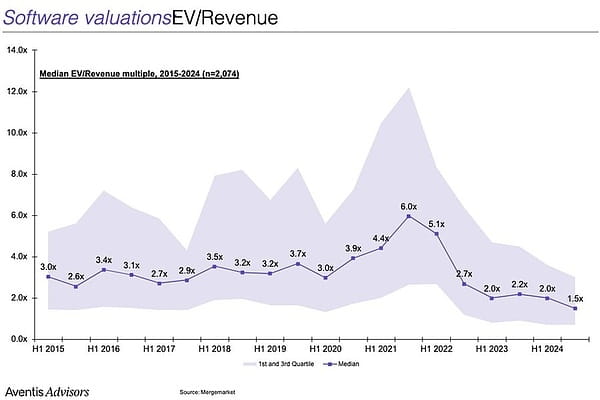
1. Crypto assets are emerging
BTC breaks through historical highs, and the U.S. president vigorously promotes crypto assets at a press conference, with regulatory tailwinds pushing this asset class back into the spotlight for the first time since 2021.
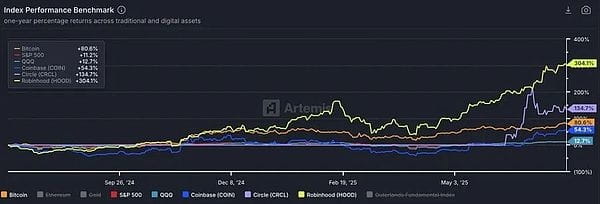
Comparison of BTC, COIN, HOOD, CIRCL with SPY and QQQ (Source: Artemis)
But this time, it’s not NFTs and Dogecoin. This time, it’s digital gold, stablecoins, 'tokenization', and payment reform. Stripe and Robinhood claim that crypto assets will be a major priority for their next phase of growth. COIN has entered the S&P 500. Circle has shown the world that crypto assets are an exciting enough growth story that growth stocks can once again ignore earnings multiples.
2. What does all this mean for ETH?
For us crypto-native players, the competitive landscape of smart contract platforms seems very fragmented. There’s Solana, Hyperliquid, and a dozen new high-performance chains and rollups.
We know that Ethereum's leading position is facing real challenges and threats to its survival. We know it has yet to solve the problem of value accumulation.
But I highly doubt Wall Street understands these dynamics. In fact, I dare say that most 'outsiders' on Wall Street are almost unaware of Solana's existence. XRP, Litecoin, Chainlink, Cardano, and Dogecoin might be more well-known externally than SOL. Let's not forget that these people have not focused on our entire asset class for years.
What Wall Street knows is that ETH has stood the test of time, has been battle-tested, and has been the main 'follower' of BTC for years. What Wall Street sees is that it is the only crypto asset with a liquid ETF aside from BTC. What Wall Street likes is that there are classic relative value investment opportunities with clear catalysts.
These suited investors may not know much, but they know Coinbase, Kraken, and now Robinhood has decided to 'build on Ethereum'. With a bit of due diligence, they will discover that Ethereum has the largest on-chain stablecoin pool. They will start doing 'moon math' and quickly realize that while BTC hits new highs, ETH is still more than 30% lower than its peak in 2021.
You might think that relatively poor performance is a bearish signal, but these investors have a different approach. They prefer to buy assets at lower prices with clear targets rather than chase high prices that make them wonder 'Is it too late?'
I believe they have already entered the market. Investment authorization is not an issue; any fund can drive investment in crypto assets as long as there are appropriate incentives. Even though the crypto community has sworn off ETH for more than a year, this token has performed excellently for a month straight.
Year-to-date, the exchange rate of SOL to ETH has fallen by nearly 9%. ETH's market cap share hit a low in May and has since seen the longest upward trend since mid-2023.
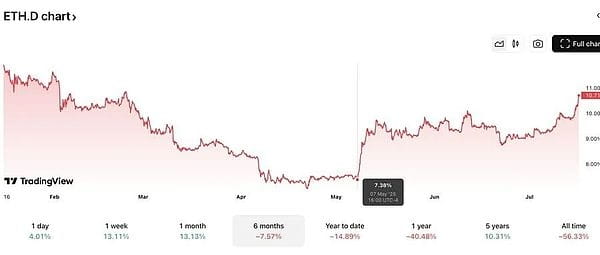
If the entire crypto community thinks ETH is a 'cursed coin', why is it still performing well?
3. It is attracting new buyers
Since March, inflows into spot ETFs have been steadily rising.
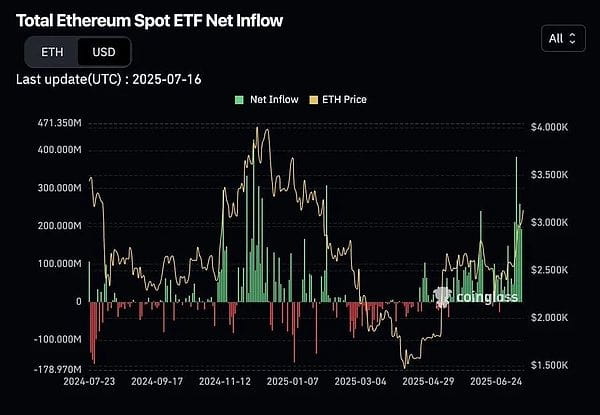
Source: Coinglass
ETH's 'microstrategy' imitators are also gaining traction, introducing structural leverage to the market early on.
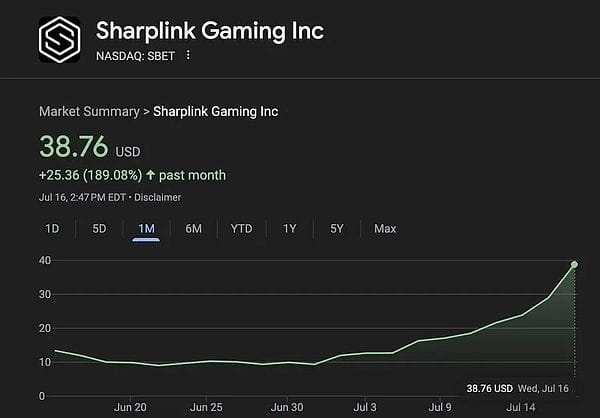
Even some crypto-native participants may have realized they have insufficient exposure to ETH and start to rotate, possibly withdrawing from BTC and SOL positions that have performed well in the past two years.
I am not saying that Ethereum has solved any problems. I believe the current situation is that ETH as an asset will begin to decouple from the Ethereum network.
4. Summary
External buyers are bringing a paradigm shift to ETH assets, challenging our view of it as 'only going down'. The shorts will eventually be liquidated. Then, our crypto-native capital will decide to chase the trend before the market reaches a peak speculative frenzy for ETH.
If this happens, new highs are not far away.




